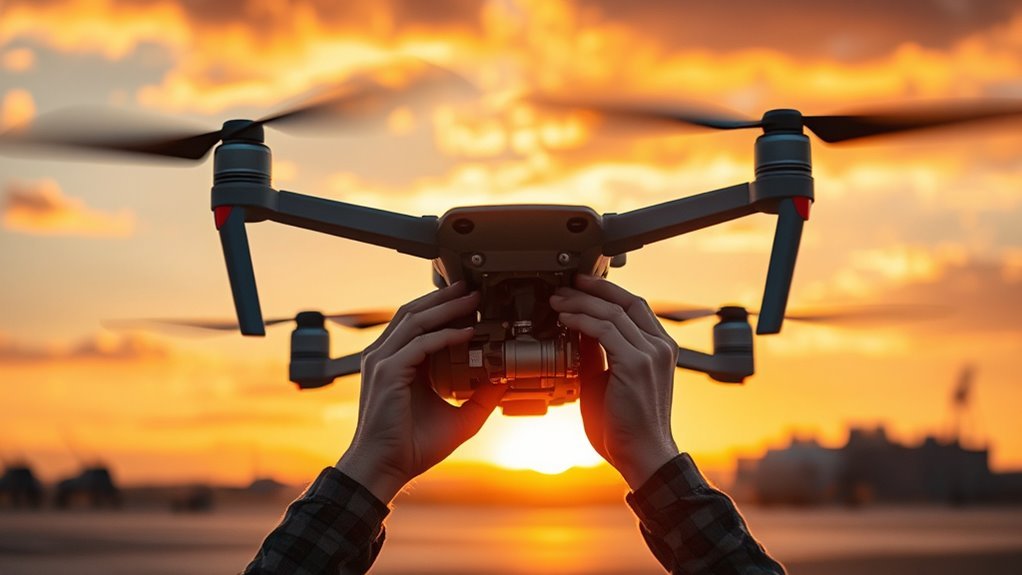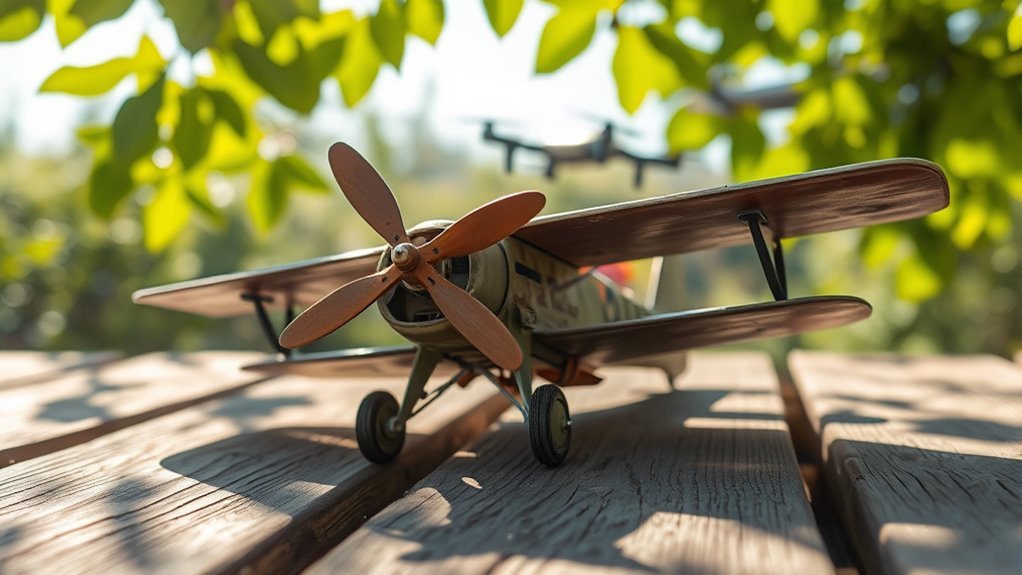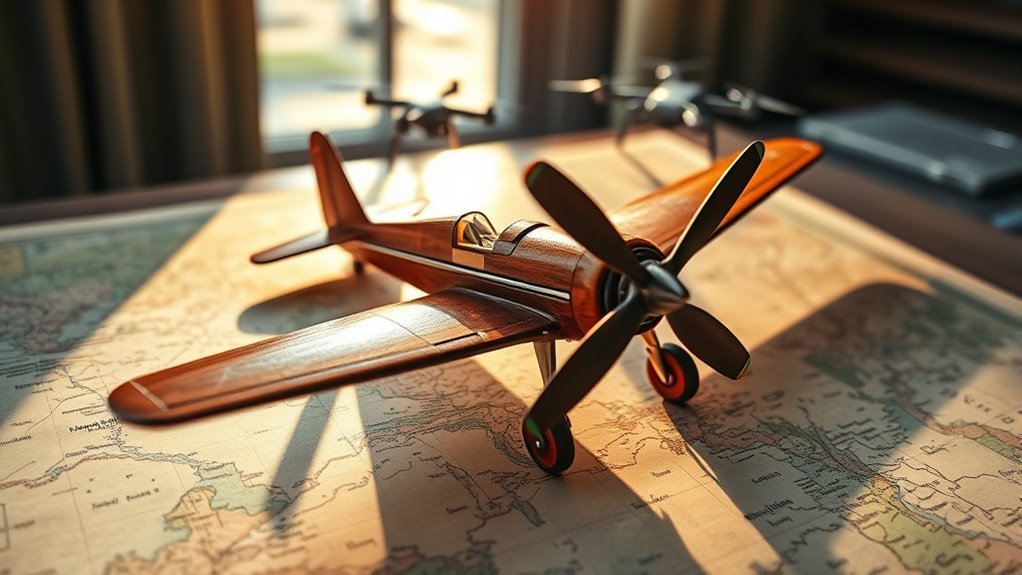Drones began with the Kettering Bug in the early 1900s, marking the first step toward unmanned aerial vehicles. This innovation paved the way for military drones, aimed at reducing risk to human pilots in combat. As technology advanced, drones found roles in various sectors, including agriculture and delivery services. Today, they incorporate AI and complex navigation systems. Understanding their origins helps you appreciate how far they’ve come and the exciting future that lies ahead.
Early Concepts and Predecessors of Drones

Have you ever wondered how the concept of drones evolved from simple ideas into the advanced technology we see today? The journey began with early inventions like the Kettering Bug in the early 1900s, which showcased the potential for unmanned flight. These primitive designs laid the groundwork for aerial surveillance capabilities, allowing for reconnaissance missions without risking human lives. As technology progressed, remote control systems emerged, enabling operators to maneuver aircraft from afar. This shift not only enhanced military strategies but also sparked interest in civilian applications. The vision of drones expanded beyond warfare, influencing industries from agriculture to real estate, ultimately symbolizing a desire for autonomy in exploration and innovation while challenging traditional boundaries of flight and surveillance.
The Birth of Military Drones

As military conflicts escalated in the 20th century, the need for safer reconnaissance methods led to the development of military drones, marking a significant turning point in aerial warfare. Initially, these unmanned aerial vehicles (UAVs) emerged from the desire to minimize risks to human pilots in hostile environments. With technological advancements in remote control and surveillance capabilities, military applications expanded rapidly. Drones provided real-time intelligence, enabling strategic advantages on the battlefield. You’d see their use evolve from simple surveillance to precision strikes, demonstrating a shift in military tactics. The introduction of drones not only changed the dynamics of warfare but also raised ethical questions about autonomy and accountability in combat, challenging our notions of freedom and human involvement in conflict.
Innovations in Drone Technology

While the military applications of drones have garnered significant attention, innovations in drone technology have also transformed civilian sectors, revolutionizing industries such as agriculture, delivery services, and environmental monitoring. You’ll notice that advancements in drone design have made them more efficient, lightweight, and user-friendly. For instance, the integration of AI and machine learning enables drones to autonomously navigate complex environments, greatly enhancing their utility. Real-time data collection capabilities facilitate immediate insights into environmental conditions, further expanding the roles of drones in various applications. Battery technology advancements extend flight times, making them ideal for long-range inspections and data collection. Additionally, modular designs allow for easy customization, catering to specific industry needs. These innovations reflect a growing trend toward democratizing drone technology, empowering individuals and businesses to harness aerial capabilities that were once reserved for military applications. The development of advanced camera capabilities further enhances the versatility of drones, enabling high-quality visual content creation in various scenarios.
Civilian Applications and Commercialization
Although drones were initially developed for military use, their rapid adoption in civilian applications has sparked a wave of commercialization that’s reshaping various industries. You’ll find drones revolutionizing recreational usage, allowing enthusiasts to explore photography, videography, and racing like never before. Beyond leisure, agricultural monitoring has become a game changer for farmers, enabling precise crop assessments and efficient resource management. This technology empowers you to analyze soil health and optimize irrigation, ultimately boosting yields. Recently, advanced drone features like dual camera systems have become more accessible, enhancing the capabilities of consumer drones. As these applications expand, both new startups and established companies are entering the drone market, creating diverse opportunities for innovation. The democratization of drone tech not only enhances your freedom to explore but also drives economic growth across sectors, paving the way for a more connected and efficient world. In addition, the integration of advanced AI and autopilot capabilities is making drones more user-friendly and accessible for hobbyists.
The Future of Drones and Emerging Trends
With advancements in technology rapidly evolving, the future of drones promises to be transformative across multiple sectors. You’ll see autonomous navigation becoming the norm, allowing drones to operate with minimal human oversight. This shift not only enhances efficiency but also opens up new possibilities for precision tasks. In environmental monitoring, drones will play a significant role, providing real-time data on climate change, wildlife habitats, and pollution levels. Imagine drones equipped with advanced sensors flying over forests to assess health or surveying oceans for plastic waste. As these technologies converge, you’ll find drones becoming indispensable tools for sustainability and innovation, empowering you to explore a world where freedom and responsibility coexist harmoniously. The journey ahead is exciting and filled with potential, especially as AI-driven autonomous navigation becomes standard in consumer drones, enhancing safety and efficiency. Furthermore, advancements in AI-enhanced obstacle avoidance will ensure that drones can navigate complex environments safely, reducing the risk of collisions during their operations.
Frequently Asked Questions
What Are the Main Types of Drones Available Today?
Drones are like modern-day flying canvases. You’ve got recreational drones for personal exploration and fun, while commercial drones serve industries like agriculture and delivery, each type offering unique capabilities to fuel your freedom and creativity.
How Do Drones Work Technically?
Drones operate through advanced drone technology, utilizing flight mechanics like lift and propulsion. You’ll find they rely on sensors and software for navigation, allowing them to maneuver autonomously or via remote control, enhancing freedom in various applications.
What Are the Safety Regulations for Drone Usage?
Imagine a rogue drone, zooming like a caffeinated bird; you wouldn’t want that chaos! For drone safety, guarantee regulatory compliance—register your device, respect no-fly zones, and keep your flying freedom within legal boundaries. Stay safe!
Can Drones Be Used for Environmental Monitoring?
Absolutely, you can use drones for environmental monitoring. They’re invaluable for environmental assessments, enabling detailed data collection for wildlife conservation efforts, helping you track habitats and species without disturbing natural ecosystems, promoting a more sustainable approach to conservation.
How Are Drones Impacting Job Markets Globally?
“Every cloud has a silver lining.” While drones can cause job displacement, they’re also creating new opportunities in fields like logistics, agriculture, and environmental monitoring. You’ll find a shift that demands adaptability and innovation in today’s workforce.

